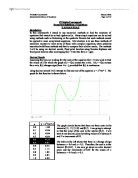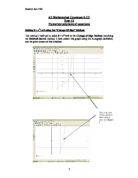Newton-Raphson Method
The Newton-Raphson method takes a value of x close to the root which is to be found and then uses and iterative formula to generate a value which is closer to the root. This process is then repeated on the new x values until they converge on the root to the required level of accuracy. Taking x0 as the first guess at the root, the tangent to the curve at (x0,f(x0)) crosses the x axis at x1, the second guess. This gives the iterative formula xn+1=xn-f(xn)/f'(xn)
This method will be used to find the roots of the equation f(x)=−x³+3x²+5x−3=0
Taking -2 as the first guess, the following results are obtained:
Therefore x=-1.53407020 ± 0.000000005
To confirm this root there must be a change of sign. f(-1.5340703) = 1.16*10^-6.
f(-1.5340701) = -1.08*10^-6. Therefore there is a root as the function is continuous.
These two diagrams show the convergence of the iterations at different magnifications. It is shown that the root lies between -1.53407035 and -1.53407025.
Taking 1 as the first guess gives the following results
Therefore x=0.48269595 ± 0.000000005
f( 0.48269594) = -1.08*10^-7. f(0.48269596) = 0.0113
Therefore there is a root as the function is continuous.
Taking 4 as the first guess gives
Therefore x=4.05137424 ± 0.000000005
f(4.05137423) = 2.34*10^-7 f(4.05137425) = -1.65*10^-7
Therefore there is a root as the function is continuous.
This method can fail for some starting points such as ones where the gradient of the curve is very small which can lead to the iterations converging on the wrong root. For the equation ¼x³−½x²−2x+3=0, an initial guess of 2.35 to find the root between 0 and 3 makes the iteration converge on the root between -4 and -2 as shown below.
Rearranging f(x)=0 in the form x=g(x)
In this method the equation f(x) is rearranged so that x is equal to a different function g(x). Then a guess of the the root is made. The value of g(x) at this point is then taken as the next guess and this process is repeated to converge on the root. This gives an iterative formula xn+1 = g(xn)
This method will be used to find roots of the equation f(x)=¼x³−x²−3x+7=0
This equation can be rearranged to give x=( ¼x³−x²+7)/3.
The iterations are applied using the starting point x=2 to give the following results
Therefore x=1.75650874 ± 0.000000005
f( 1.75650873) = 5.18*10^-8. f( 1.75650875) = -3.22*10^-8. Therefore there is a root as the function is continuous.
This diagram shows the convergence of the iterations on the point where the line y=x and the curve y=g(x) intersect. This is the root of the equation f(x)=0
At the root x = 1.75650874, g'(x) = 0.479 (3sf). ¦g'(x)¦<1 for the iterations to converge.
If ¦g'(x)¦>1 the iterations will not converge on the correct root. For example sing the same rearrangement of the equation to find the root between 5 and 6 using 5 as the starting point, the iterations converge on the root between 1 and 2. using 6 as the starting point causes the iterations to diverge away from the root. Both examples are shown below.
Comparison of Methods
The methods will be compared using the equation f(x)=x⁵+x⁴−2x³+5x²−7x−2=0 and finding the root between -3 and -2 found above using the change of sign method
Using the Newton-Raphson method with the starting point -3 gives the results:
Therefore x = -2.72115745 ± 0.000000005
f(- 2.72115746) = -1.47*10^-6. f(- 2.72115744) = 8.29*10^-7. Therefore there is a root as the function is continuous.
f(x)=0 can be rearranged into the form x=g(x)=(x⁴−2x³+5x²−7x−2)0.2
The x=g(x) iterations are applied to give the results:
Therefore x = -2.72115745 ± 0.000000005
f(- 2.72115746) = -1.47*10^-6. f(- 2.72115744) = 8.29*10^-7. Therefore there is a root as the function is continuous.
Comparison of the three methods
Based on the examples used above, it seems that the Newton-Raphson method is by far the most efficient method of evaluating a root as it only took 4 iterations compared to the 7 intervals that were tested in the change of sign method and the 35 iterations in the x=g(x) method. This shows that generally the Newton-Raphson method has a much quicker speed of convergence than the other two methods. The change of sign method converges quicker than the x=g(x) method making it more efficient in this respect.
The change of sign method was fairly easy to use as it requires little extra hardware or software and can be carried out manually if necessary using only a calculator. This makes it particularly useful if computer software is not available. However the need for much manual computation can make the process quite laborious and time consuming. The Newton-Raphson and x=g(x) methods are relatively similar in terms of ease of use with hardware and software. Both make good use of Autograph software visually interpret equations before using an Excel spreadsheet to carry out the calculations to find each root. Compared to the change of sign method both are generally more easy to use as once the initial formula has been entered it is very quick and simple to do the iterations many times.








